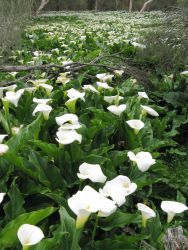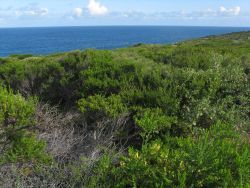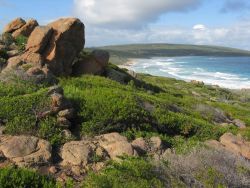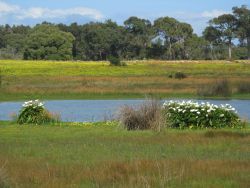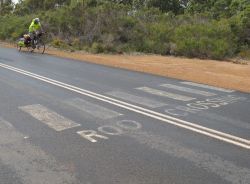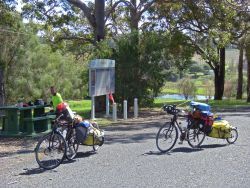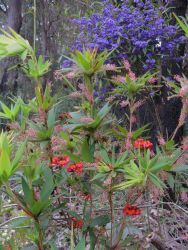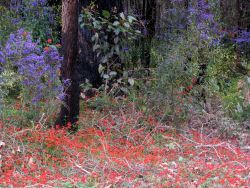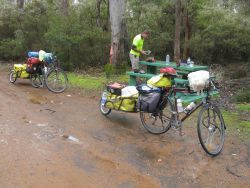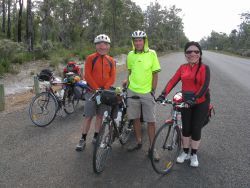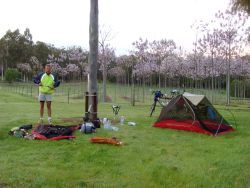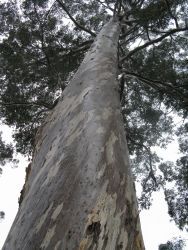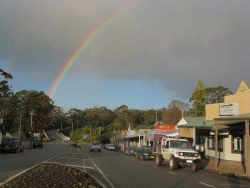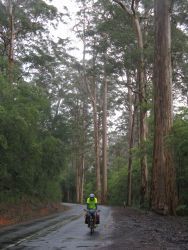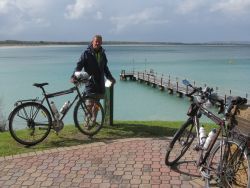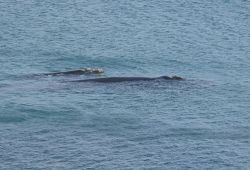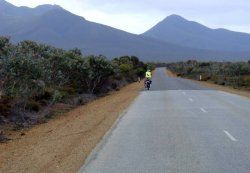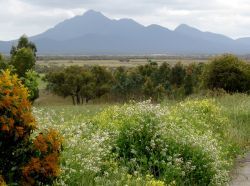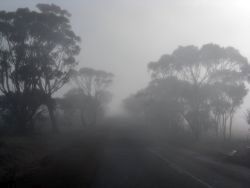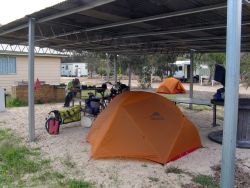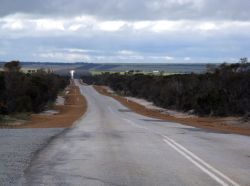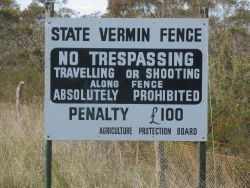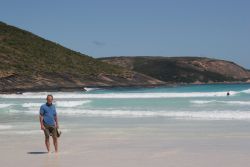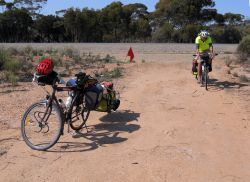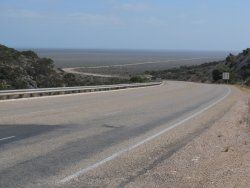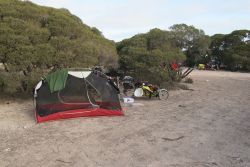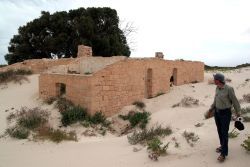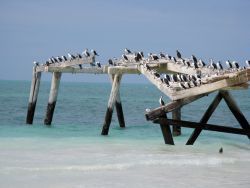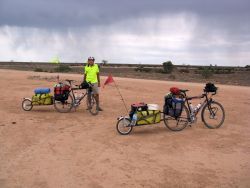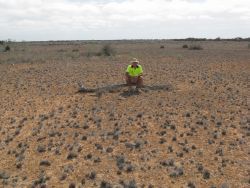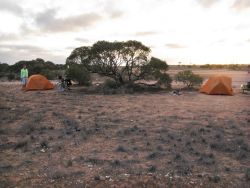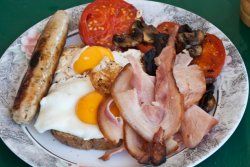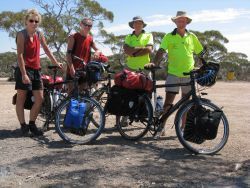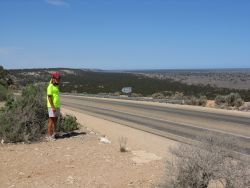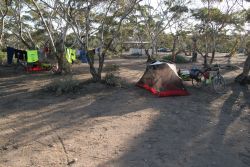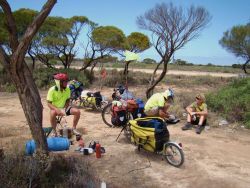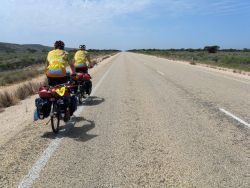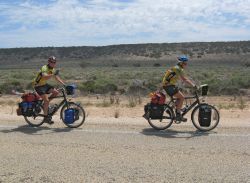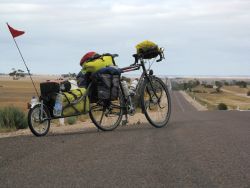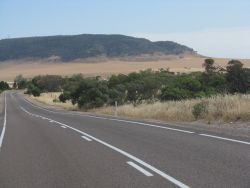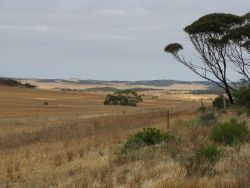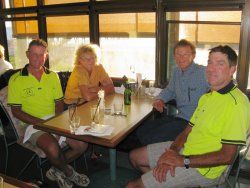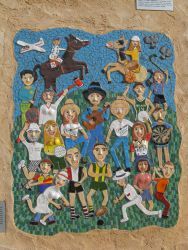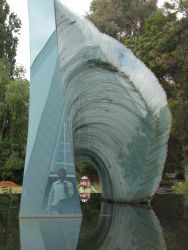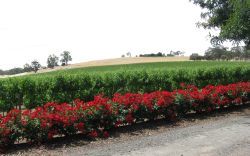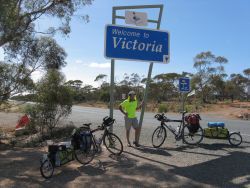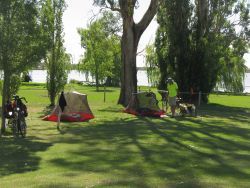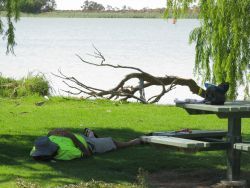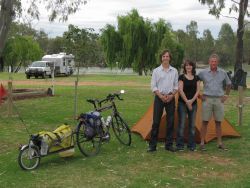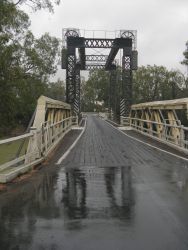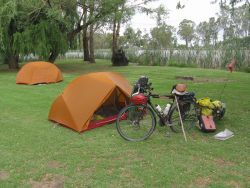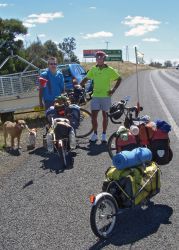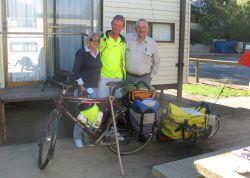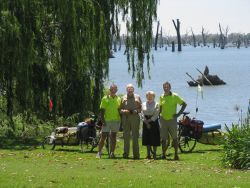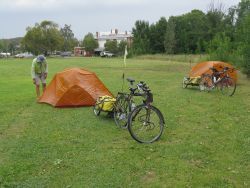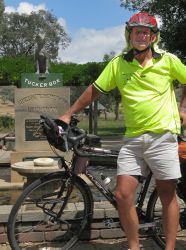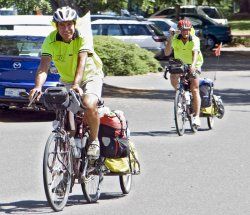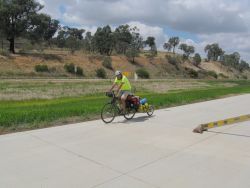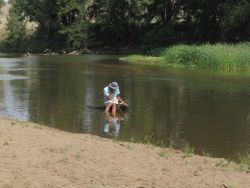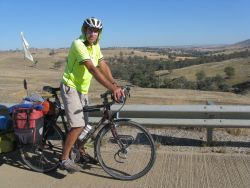We was dun with Dunsborough
One thing we appreciated as we pedalled around from town to town or roadhouse to caravan park was the authentic charm to be found just about everywhere. Out the back of the Sandfire Roadhouse, the most islolated barren-looking environment we had encountered, was evidence of a once-thriving local rodeo scene, now a victim of the changing prorities of the local population. Leaving Balaklava, north of Adelaide, we chanced upon an amazing wall of ceramic paintings the likes of which we had never seen anywhere else. Just about every little settlement had something going for it that reminded the visitor of some element of heritage or culture.
Then there was Dunsborough. Apparently it was a nice little town at some point in the past. Now the visitor drives past a Florida-style golf course development with kitschy little lakes and fountains, into a shopping precinct of fake cobblestones and shops based on a heritage look but still smelling of new paint and franchisees. To top of the rather less than stay, the caravan park was the most expensive for the whole ride despite being way out of town and having poorly drained tent sites around very average facilities.
Just out of this fake little town, up over a small hill, we returned to normality at Yallingup, itself a little spot of tourist-based endeavours, but somehow seemingly more genuine. From there we wandered off down to the paradise that was Margaret River. I guess being a part of the unpretentious outback for so long, the rather contrived atmosphere of a wine centre, with its oversupply of BMW driving couples sipping overpriced chardies seemed just plain incongruous and we weren’t sorry to head out of town after a brief stopover.
From bad to good company near Pemberton
From just south of Margaret River the road turned east and our spirits were riding high, knowing the last leg was underway. Riding through the scrub with occasional patches of wildflowers to compensate for the quite undulating terrain was part of made riding special. After a good couple of hours we chanced upon a couple of cyclists wending their way from Albany to Perth, and we stopped to talk and swap stories, in the finest tradition of the long distance touring cyclists.
It wasn’t long before we wished we had kept pedalling. The male of the couple turned out to be a schoolteacher, and his partner seemed rather quiet, though we detected she wasn’t finding the ride easy. The old saying that “those who can, do, and those who can’t, teach”, probably applied to this bloke. Within a minute of meeting us, he told us we didn’t need all the baggage we had on board. He pointed to his rather more sparse kit, declaring with the arrogance of someone not used to being contradicted that he had all that was needed for a cycling tour. We pointed out that we had had the best part of six months to fine tune our load to the bare minimum for true long distance riding, but he was not to be swayed, after all he was a teacher and therefore supremely knowledgeable.
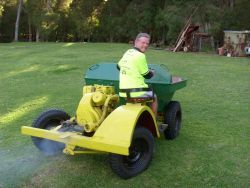 |
|
Steve even gave us
some practice at |
Declaring that time was precious we excused ourselves from the one-sided conversation and in considerably less good humour headed for what the cycling guide reckoned was a good riverside camping spot not far from Pemberton. On arrival at the Donnelly River, we found the spot, but it had been allowed to overgrow and there was mess from other campers spoiling the ambience. On the other side of the road was a green grassy property with what looked like perfect riverbanks to camp on, so on a whim we went in and asked the owner, Steve, if we could camp. The winery across the road had turned us down for a few square metres of grass but Steve took the time to show us the softest grass on the riverbank away from the road. To cut a long story short, he enthusiastically agreed, we set up tents, and then spent the rest of the day and evening in his great company and departed next morning in great spirits for the short ride into Pemberton.
So in one day, we met a dropkick, who for the sake of this paragraph we’ll call Mr Chalk, but later we met a top bloke, who for comparison’s sake, must be called Steve Cheese.
Candidate for worst day of the ride #2
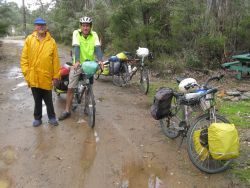 |
|
Steve, we takes our
hats off to you, and |
From Pemberton the road heads south towards the coast before turning west in the direction of Albany, winding and undulating through the Karri forests in a spectacular part of the world. Along with the spectacle comes the penalty, the topography. Although there was hardly a noticeable wind to help or hinder, the journey was composed of non-stop ‘Tobleroning’, a cycling term for heavy undulations.
|
|
From the Atherton Tablelands half a continent away, right around through Broome, the roads had been essentially flat and therefore, even when the wind gods didn’t smile, it was rare to see less than 12 km/hr on the speedo. We knew that the country around Pemberton was hilly, so we were prepared, but it was still a frustrating ride. Unlike in a car, where the only thing a driver notices is a slight shift in the loud pedal position as the road rises and falls, a cyclist is only too aware of the all-pervading force of gravity, especially with 40 odd kilos of dead-weight luggage to haul against it. Even when the lengths of the ascents match the descents, the cyclist is not spared. The rush of the downhill section is over in as little as two brief minutes of 40 km/hr refreshing wind, then the load of the pedals is taken up again as the speed drops to 8 km/hr, and for ten or more minutes muscles strain against what feels like an anchor attached to the trailer. To top off the toughness of the leg, we were riding through regular showers that lifted the humidity to tropical levels.
We had just pulled away from a welcome tea stop when I spotted a cyclist in a pull-off area, and as custom dictated, we pulled in for a chat. Steve was on the last few legs of a ride from Melbourne to Perth, and was preparing to spend a few hours reading and resting. As we talked our own discomforts and travails of the day’s ride quickly evaporated in admiration for this cyclist’s determination. Turned out Steve had the use of only one side of his body. His left leg and hand were clipped onto the bike but had no power or useful function. Just to be riding a bike laden with panniers up and down the hills with only half the power we had was an incredible achievement, let alone out in the middle of nowhere with at least two day’s of riding to cover the ground we had done just that day.
Even though the road became easier not long after we said our goodbyes to Steve, any tiredness or lack of enthusiasm we might have had could not surface, as his strength and determination against the odds made our own efforts seem so puny and it was many days before I again allowed myself to think our ride was in any way tough.
Testing the tents
Albany was a welcome stop after the challenges of the Pemberton forests and we had the best part of two days to explore the picturesque scenery in between scudding showers that drifted in from the Southern Ocean. The showers were generally light with only moderate associated winds and even when we were caught out at the end of the scenic cycle path we were dry by the time we got back.
Several of the locals had sung the praises of a fish and chips shop a couple of kilometres up the road. The night was wet and we donned raincoats and headed off on foot to enjoy this sumptious feast a couple of kilometres up the road. We had quite a wait in the rather spartan waiting area of the shop and with nowhere else dry enough on a wet night we ate in the same small waiting area, on our laps as the shop was not designed for eating in. As it turned out the food was quite ordinary so we could have saved ourselves a drenching in the rain.
As we started back a squall came in driving the rain horizontally with gusts of more than 60 km/hr. Then first thought was for the gear back at the campground, did we have our clothes away from the tent walls etc? With a little trepidation we got back and inspected the tents. Not a drop had got past or under the tent flies, the inside was as dry as the Pilbara, and this despite rain that was coming in horizontally with gale force winds. My hat goes off to the makers of the MSR Hubba Hubba tent, chosen for its incredibly light weight more than its rain shedding capabilities, but it passed the test with flying colours.
Most challenging topography
The title for the most challenging topography on our route was a four-way contest between Gympie and Atherton Tablelands in QLD, and between Pemberton and the roads around Ravensthorpe in SW WA. And the winner was… the roads around Ravensthorpe.
While the other areas have more undulations, the scale of the climbs and descents on the South Coast Highway from Jerramungup to Ravensthorpe meant that for most of the climbing sections, at 8 km/hr or less, involved continuous exertion for up to 45 minutes with no respite, other than a quick 5 minute scoot down the other side to the next river channel before again climbing out. The reason for the large scale topography appeared to be the age of the landscape, the rivers that flow south towards the Bight having cut deeply into the landscape, albeit relatively gently. After the first couple of long descents and climbs I pulled out the GPS and the next descent measured 400’ down and nearly as much up again. This pattern continued all the way to Ravensthorpe, including a punishing last ascent before finally the road descended into Ravensthorpe and we made our weary way to the campground.
Following in the tyre tracks of others
Not far out of Norseman in the early stages of crossing the Nullarbor we pulled into a rest area to boil the billy and headed for a low rock wall that looked like it had been knocked up from left-over rocks used in roadworks. There was a small gap between the two halves of the wall, and each side was an ideal place to sit and put out the tea-making gear.
It was while waiting for the water to boil that we noticed a tyre track leading through the same gap that we had wheeled our bikes. It was different to ours, being a real knobbly mountain tyre impression, rather than the relatively smooth tracks created by our touring tyres. Although it should not have come as a surprise that we would pull into the same area and head for the same spot as other cyclists, it was still a surprising sight out there in the almost absolute isolation of the Nullarbor. We pondered for a while about how long it had been there and what style of cyclist was crossing the Nullarbor on a fully-fledged mountain bike, until it was time to pour the delicious refreshing golden nectar that was Bushells tea and concentrate on whether there was a slice of fruit cake to go with it.
Half a continent later…
|
|
|
"See you on the
Nullarbor" was meant as
a |
Way back at Sandfire Roadhouse south of Broome Pete had met up with a couple of motorbike tourers heading around Australia the opposite way to our trip. As Warren and Fran headed off they flippantly said they would see us on the Nullarbor in a couple of months time.
Well, despite the odds against seeing them, at Caiguna Roadhouse we were in the final stages of packing up after eating breakfast at a table out the front (there being no camp kitchen) when amongst the constant comings and goings of all sorts of vehicles, a couple of bikies wandered over and sure enough, it was the couple from Sandfire Roadhouse. The amazing thing was they had originally planned to ride past Caiguna and continue on to Balladonia when, on a whim, they called in for a coffee and a pit stop. There had been many people that we had met on the ride who we ran into all the way around, mostly caravanners who often travelled similar distances to us each week, but we never pretended that we could say to someone we would see them later on and actually expect to both be there at the same time. This then was the exception that all rules must have.
The most frustrating day
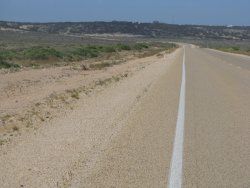 |
|
Eucla, so near and
yet so far. At this
point, only |
As we cycled across the Nullarbor the wind became more and more of a headwind. From Balladonia Roadhouse along the longest stretch of straight road in the country we had varying winds, light headwinds to start but just when we thought it was getting tougher it swung around and became a moderate tailwind for a couple of hours allowing us to post the longest distance yet, 181 kms. Then followed a couple of average days with gradually increasing headwinds. The last 30kms into Mundrabilla Roadhouse was into the teeth of a moderate headwind and I was not keen to continue if it didn’t abate.
Next day the easterly was still blowing moderately and having woken up feeling ordinary I was tempted to pike for the day, but after being shouted brekky by a couple of fellow cyclists from Dubai (more about them later) the 65km stretch didn’t seem impossible, even into a strong headwind.
Knowing full well we would be crawling along we set off at 9am and I settled on a speed of 14 km/hr, head down and concentrating solely on putting the kms under the wheels. As the day progressed the headwind increased to over 30 km/hr straight into the face, and the speed dropped to 12 km/hr or less. After a cuppa at the 24 km mark I expected to pedal for another 2 hours and have another rest but as the wind got stronger I knew it would be more than difficult to get going again after another break so I kept going. It took three and a half hours to do 41 kms, an abysmal average of just over 11 km/hr. I’m sure the slight streamlining effect of the trailers helped, with large front and rear panniers I doubt more than 9 km/hr would have been seen towards the end.
However the frustrating element of the day was not so much the sloooow speed, rather it was how little progress was apparent once Eucla appeared on the distant escarpment. The first sign of Eucla appeared in the distance as an indistinct mirage way off, initially it looked like dust-coloured sails floating in the air. Something twigged in my long-forgotten memories and I remembered seeing the same sight as an 8yo kid from the back seat of an EH Holden wagon crossing the rutted dirt road that was the highway in 1964. As the ‘sails’ gradually resolved into dunes floating in the mirage, little boxes became visible on the distant escarpment. Eucla was in sight. But frustratingly, with the clear desert air, and the lack of meaningful speed, every time I looked up after pedalling for ten minutes or more, the little boxes seemed no closer.
Eventually basic physics prevailed and the forward motion of the bicycles translated into tangible distance, and the long-awaited ‘Eucla 5km’ sign was passed. Only a couple of straights, around a bend and a climb up the escarpment was between me and a long cold ginger beer or several. The edge of Eucla was clear as a bell almost close enough to reach out and touch, yet it took a full half an hour of gruelling effort to finally get there. At the top of the escarpment I looked back to see if I could see Pete, but even the nearest vehicle was just a dot in the distance, and no sign of an even smaller dot anywhere.
Pete rolled in just as buggared maybe 30 minutes later, he had taken the view that it wasn’t worth fighting the wind, and his day wasn’t that much longer overall despite accepting a 1-2 km/hr slower pedalling speed.
There was no real sense of achievement having beaten such a strong headwind, the frustration factor took over and made the day not one to remember fondly. It was the slowest average speed of the whole ride despite being on a pancake flat road.
Nothing like muesli
All through the ride we started the day with a big bowl of muesli and milk, and sometimes bread and fruit, or even toast if we had the luxury of a camp kitchen. Generally this was enough to get us through the first three hours of pedalling before the petrol tank gauge hit empty and lunch was called, often around 11 am. On the east coast where shops and cafes were easily found ‘lunch’ would often be a big brekky in a cafe. If we had to ride past 1pm we would have a second lunch as well, and then a big protein laden dinner.
The two German cyclists from Dubai, Tanja and Wally, whom we met on the Nullarbor and were meeting up with every now and then, shouted us a big brekky at Mundrabilla Roadhouse prior to heading off into the headwind to Eucla. Forgoing our bland muesli for this gift of a flavour-filled plate of eggs and bacon, sausages and hash browns, mushrooms and toast we hoed in thinking that the sheer bulk of food would see us through past lunchtime.
Well, when we stopped at the 24km mark after less than two hours pedalling we were both hungry and had to dip into the panniers for an early lunch. We had suspected that there was nothing like a good serving of low GI muesli to provide energy and burn up the previous night’s protein-laden dinner. The combination of a big steak and three veg dinner with a high carb breakfast fitted in with our understanding of how food is processed for energy as well as stamina. While hardly a scientific test it was enough to convince us that muesli contributed mightily to the success of the whole ride.
Hot and cold on the Nullarbor
After Eucla and the Border Village the road runs along very close to the cliffs marking the Great Australian Bight, and as in most parts of the country you would expect the close proximity of the ocean to provide a cooling effect. Not along the Nullarbor though. The cliffs act as a barrier against any tendency for an onshore wind to develop and all we could feel as we pedalled through the vast emptiness was a hot dry northerly.
That was until mid-afternoon, when a mild front moved through bringing some unsettled wind patterns. We could see a change in the clouds and hoped that there might be a little rain to cool things down. Suddenly, from riding through a northerly wind at close to 40 degrees, there were little chilly puffs and eddies, mixing cooler air in with the hot. At one stage, within a couple of turns of the pedals, the air changed from over 35 degrees to maybe 20 degrees, and for 50 metres it’d be refreshingly cool, until the hot dry wind again replaced the intruding air. The effect was just as though we had ridden into a frig, then out the other side, and so on. This cycling pattern of hot and cold went on with decreasing intensity for half an hour or so, until eventually the warm to hot northerlies resumed and that was the end of the strange temperatures of the Nullarbor.
Dry throats and no help from water
The Nullarbor was by my reckoning the driest air of the whole ride. So dry in fact that the intake of water by our plumbing systems wasn’t sufficient to counter the amount our bodies were using. Up in the Pilbara I had tried with limited success to drink one sip every 500m and three or four every 2.5kms, but even with that regular replenishment I could feel my mouth and throat becoming drier as the day wore on. Most mornings I would deliberately not start drinking any water for the first hour or so. This flew in the face of perceived wisdom but I noticed that undiluted spittle in the mouth provides a moist coating that water from the drink bottle tended to flush away. After an hour or so the dry air overcame this effect and drinking sips was the only way to prevent total dessication of the mouth and throat.
Once I realised that the Nullarbor air was so dry, I started to breath only through my nose, which helped prevent the mouth and throat from getting dry and consequently sore. This strategy limited the air intake somewhat and often in the second half of each day’s ride I was pedalling 1-2 km/hr slower than if I had been breathing with mouth open. And no matter how much I sipped, the mouth and throat just got drier and drier. I would take a mouthful and hold it for 250m, then swallow it, and by the time another 250m had disappeared under the tyres the throat would again be as dry as the paddocks around us.
The hottest day was after leaving Nullarbor roadhouse, the temperature was in the low 30s as we left at 8am and by early afternoon was into the 40s. Pockets of air on some of the more protected sections of road felt like we had briefly ridden into an oven. No matter how quickly we sipped our water bottles, we were slowly drying out, luckily the lunch rest stop at 70kms had a water tank. Despite the obligatory placard warning that the water may not be fit to drink we filled up our bottles and drank as much as we dared. It was only 21 kms further to Yalata Roadhouse so after lunch we pushed on through the heat. The roadhouse was boarded up but had big rainwater tanks and once again we drank and drank to rehydrate somewhat. It was a further 52 kms to Nundroo Roadhouse which would not have been possible without the extra water from the tanks. A sure sign I was unable to hydrate properly was a large crack in my lower lip. Finally after 143 kms on an almost dangerously hot day we made Nundroo. My diary records that on arrival at the roadhouse I had three flavoured milks and an orange juice, followed over the next hour by three schooners of iced water, and I was still pathologically thirsty until well after dinner.
The huge volume of liquids that we were forced to put through our systems upset the electrolyte balance and there were some days in the Pilbara as well as the Nullarbor when my hands and fingers would cramp up, sometimes for hours at a time. Towards the end of the Nullarbor I tried sports electrolyte drinks and they appeared to help with restoring normal tendon functioning.
Overall, it appears that there were certain conditions in which it was impossible to keep up with our bodies’ usage of water. This was OK in the short term and our schedule catered for sufficient rest stops to recharge. It did highlight the necessity to carry adequate water so that on hot dry days we could continue the throughput of life-giving water to keep the pedals turning.
Tyre pressures matter
A couple of times on the ride the energy didn’t seem to be there, even though no physical symptoms were apparent. Leaving Camooweal I was having to stop pedalling regularly to avoid running into the back of Pete’s bike. Turned out his front wheel dynamo had somehow developed a load (short circuit?) and it was as though he was climbing a constant hill. Generally though, the bikes rode well.
After Ceduna we stopped at Smoky Bay, and the next day I didn’t seem to have any energy. I felt fine but the pedals seemed a bit heavier than normal and Pete was having trouble not running up behind me. Nothing about the tyres felt any different so I didn’t initially check them. I just assumed I had a mild virus or something sapping my energy. After quite a while I happened to detect a slight change in feel of the steering as I turned into a corner and looking down the front tyre did appear to be slightly bulgier than normal where it contacted the road. An inspection revealed that it had dropped to under 20 lbs of pressure. A quick pump-up restored its normal 70-80 lbs and when I resumed pedalling it was like I had gained a new lease on life.
We had been keeping an eye on the tyre pressures right through the whole ride, finding that over 4-5 days they would sometimes drop from 70 to 40 lbs at which point the rolling efficiency became just noticeably less. After fitting new tyres in Perth the rate of pressure loss diminished and we got a bit careless in checking the pressures as the tyres seemed to be always up.
The experience out of Smoky Bay served to ram home the importance of keeping good tyre pressures on any long ride. At the optimum 70 lbs pressure our flat road speed was probably 1 km/hr faster than when the tyres had dropped to 40 lbs, and at least 3-4 km/hr faster than at 20 lbs or so. That difference would translate to an extra hour’s effort over a whole day if not detected.
The Streaky Bay gift
After the Nullarbor and a good rest day in Ceduna we headed down the west coast of the Eyre Peninsular. As we rolled into Streaky Bay with a strong tailwind at 40km/hr on the flat, after being buffeted by gusts and being rained on earlier, life seemed good and carefree. The caravan park was in a picturesque location at the water’s edge, which, as the wind swung a little more westerly, proved to be right in the teeth of a slowly-developing gale. With winds already up to 50km/hr off the beach we elected to book into the Foreshore Tourist Park but not put the tents up until later hoping the wind would die.
To our surprise, just after we had booked a tent site, the manager came running out and gave us a key to a cabin. We were pleasantly surprised to say the least and accepted his charitable offer gladly, as the prospect of sitting around in a gale did not inspire us. The wind did die to a gentle breeze by sundown, so keeping the cabin wasn’t strictly necessary, but we didn’t want to look a gift horse in the mouth, and we enjoyed the comforts of home while we could. By this time we were so used to camping in the tents that Pete decided to put his tent up around the back, while I put my sleeping mat on the floor of the cabin, soft mattresses being less comfortable than the half inch of sleeping mat I was used to.
One degree of separation
We met up with Wally and Tanja, the two German cyclists from Dubai whom we met on the Nullarbor, in Ceduna and as ‘official’ representatives of the Aussie cycling community we presented them with a genuine ridgy-didge “I crossed the Nullarbor” certificate, signed and duly witnessed. We then bid them farewell as they headed on down to Port Lincoln, with a vague promise to meet up in Adelaide.
Fast forward two weeks and we were in Adelaide. We hadn’t heard from the Germans and assumed they had been and gone and we’d missed them. We busied ourselves catching up with the few people we knew in Adelaide and after dropping in on Pete’s local Xerox office, headed out on the bikes to Henley Beach and on down to Glenelg. In the middle of the shopping strip, thousands of people all milling about, we had just come out of a bakery preparing to head back home, when we heard a familiar voice across the road, and there stood Tanja and Wally. It was their second last day in Adelaide.
We were about 10kms from our digs at the caravan park near the city, and only in Glenelg for an hour in total, so to run into our friends was a truly remarkable coincidence. We made the most of it by catching the tram out again for dinner and seeing them off in some sort of style, (even though it was their shout it still counts doesn’t it?).
Adelaide
If I was ordered to leave Canberra and told I would be provided with digs within a couple of km of a city centre, my choice, I would choose Adelaide as the best place in Australia for a cyclist to live (capital cities that is). Although Perth had a more comprehensive network of cycle paths, Adelaide was just an ideal place to ride around. All around the city centre was a network of paths through the all-encircling parks, in the CBD proper the roads are wide and the traffic tolerant, and the arterial roads (out to the beaches at least) are dead flat and have cycle lanes. Not once in the whole time I was in Adelaide did I feel uncomfortable or threatened by the traffic, mainly because 90% of the riding was off the traffic lanes anyway.
When I compare the reception we got in Brisvegas simply trying to cycle up towards the city, with the innate cycle-friendly nature of Adelaide, the contrast opens out to a veritable chasm between the two styles of traffic and cycle management. For me there’s just no contest, Adelaide is beautiful one day for cycling, perfect the next.
Setting a new record
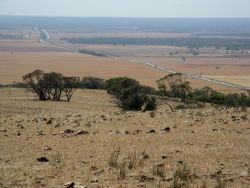 |
|
The section of road
where I set an Australian |
As we departed the Barossa we were warned about a big climb at Accommodation Hill, perhaps the locals were thinking of the other side of the hill because it was just a brief 10 minute climb to a lookout where we could see the road snaking eastwards along the level plain several hundred feet below. After taking in this view we resumed the ride and headed down into the plain on a smooth descent, wide shoulder and all. Sensing that the conditions were right I gave my bike free rein and with some assistance in top gear eventually saw 67 km/hr appear on the speedo.
For a lot of cyclists used to hooning down hills at 80 km/hr this sounds like no big deal, but none of them would be hauling a trailer that has a special sticker warning owners not to exceed 40 km/hr under any circumstances. Truth be known I was hardly aware of the trailer behind the bike, there was no vibration and after 14,000 odd kms I was pretty used to the subtle change of behaviour it introduced into the bike’s handling.
That was the record for the top speed of the ride by about 5 km/hr, the previous best speed was set between Wallaroo and Balaklava only 150 odd km to the west, on another long wide descent from a lookout to a flat plain. Must be a South Australia thing.
Statistics
Stats as a rule are boring but here are a few just to make you yawn before proceeding:
Total distance pedalled 15,840 kilometres, of which ~3480 was up the east coast to Cairns, ~4150 across the top to Broome, ~2530 down to Perth and around 5,680 back to Canberra via the SW of WA and following the Murray River to Albury.
We had 216 days away from home, the average speed for that time was 72 kms per day. Take out rest days and the number of cycling days was 172 giving an average distance of 91 km each pedalling day.
The average speed around Australia worked out to 19.3 km/hr while we were pedalling. The slowest daily average was 13 km/hr into Eucla with a 30+ km/hr headwind, the fastest daily average was 26 km/hr towards Three Ways in the NT, with a 30km/hr tailwind. (Note that if you take the average of the fastest and slowest days, the figure is almost exactly the average for the whole ride. This reinforces my theory that wind direction rather than topography is the main determining factor in average speeds.)
One day, out near Barkly Homestead, on one of the long lonely and frankly not very scenic stretches road, my mind began to wander and for some reason I started to wonder how many pedal strokes we would attain for the whole ride. Totally unscientifically I estimated that with the number of hills, level sections and head and tailwinds we faced over the whole ride the average of all gear usage would be somewhere in the middle of the 27 gears available. So, to pass the time, I counted the total number of pedal strokes it took to advance one kilometre in the middle gear. The figure came out to a nice round 400. With my mathematical genius and a calculator I have been able to extrapolate a figure for the whole 15,840 kms: and the answer is about 63,360,000 left and right pedal strokes in total. You needed to know that.
Familiar faces
Not far from home along the Hume Highway on the second last major leg, between Jugiong and Yass, we were tootling along with only half of the day’s 65km left to ride when a pickup and trailer pulled over in front of us and out hopped Rod Barnes, a mate from way back. Turned out he was heading for Wangaratta and mindful that we might be somewhere along the road had spotted us going the other way and chucked a u-turn at the bottom of the hill and driven back to say g’day. It was good to see such a familiar face and brought home the feeling that within 48 hours it would all be over after seven long months.
Later on, at the caravan park in Yass, we got a phone call from another Canberra friend, Rod Hewitt Cook, who had been following the ride with great interest but was leaving for Queensland the day before we were to ride triumphantly into Lennox Gardens. Never mind, he said, he would go via the Newell Highway which meant an exit via Yass. Next morning sure enough, Rod and Betty stopped in for an hour or so and a cuppa, and then departed north while we meandered slowly down towards Hall, on the outskirts of Canberra, to camp for the last time within sight of the end of the ride. We couldn’t just ride in and finish because there was to be a welcome at Lennox Gardens at 2 pm, we were adamant we were going to arrive on the dot of two and the safest way to ensure nothing could go wrong was to be in sight of the finish with a day to spare.
Did we ever leave?
The end of the ride was at once an anticlimax and a climax to the whole seven months. We rode in to Lennox Gardens to a welcome from around 50 friends and relatives seven months and a day after riding out on that chilly May morning. A couple of interviews and a photo op preceded an official welcome by Pete’s work and a local government minister, and in between I was pretty much in a daze, catching up with friends and getting used to the idea of being back.
After a while the hullabaloo died down and some had drifted off and I had a few moments to look out over the lake towards Black Mountain, a very familiar view, and for a brief moment it seemed I had never left. I expected to find that feeling returning after a few days back, but to have it manifest itself within an hour of getting off the bike was pretty remarkable. It was honestly, for a few moments, difficult to grasp the concept that I had been away for seven months and ridden almost 16,000 kms right around the continent, so familiar were the faces, sights and sounds all around.
I still find it hard to make sense of the time and distance involved, the facts speak for themselves and yet when I try and rationalise the achievement into some sort on manageable mental concept, it’s almost as though I had stepped out of myself for that period, and only stepped back in after the return. The person who rode around Australia was almost an alter ego, who jumped ship shortly after the ride’s end and still hangs about, separated by a subtle but nevertheless tangible division of character.
